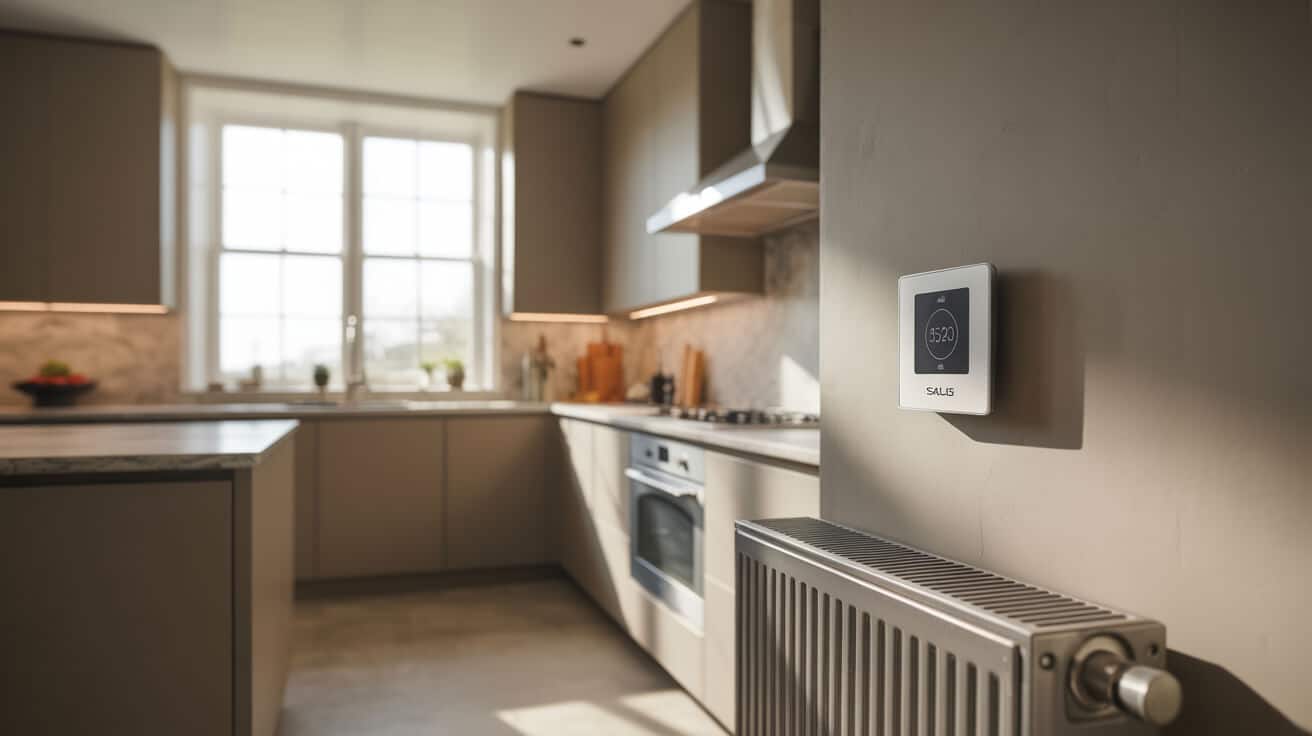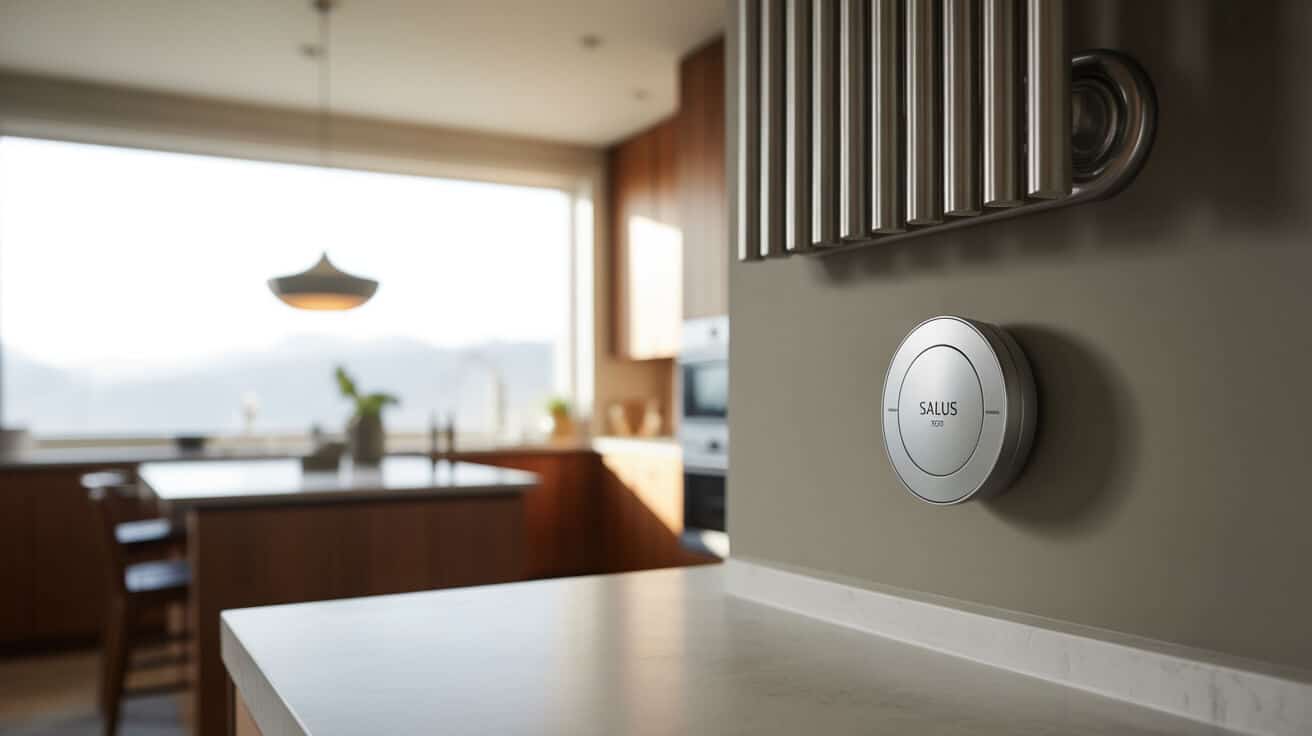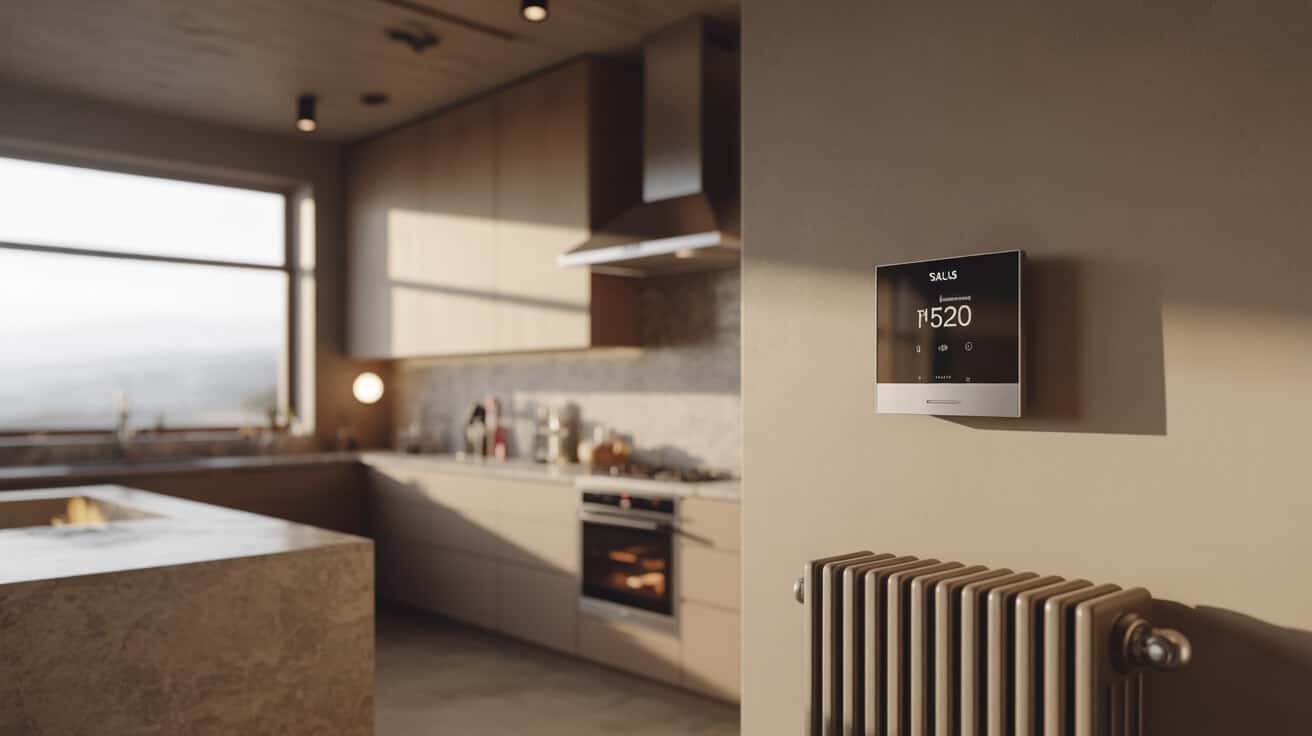Salus RT520 thermostats are widely used electronic controls engineered for integration into modern central heating systems. Manufactured by Salus Controls Ltd, these devices enable users to define customised heating schedules, automate system operation, and improve the energy profile of residential and commercial premises. The RT520 series, and its wireless (RF) and transmitter (TX) variants, are frequently chosen by property managers and service providers such as Plumbers 4U to fulfil compliance-driven and comfort-focused requirements, supporting rental and owner-occupied portfolios alike.
Etymology or name origin
The designation “RT520” follows a systematic naming structure adopted by Salus Controls, with “RT” denoting Room Thermostat and “520” signifying its generational ascent within the product line. The Salus brand name, derived from the Latin for “safety” or “wellbeing,” underpins the company’s identity as a provider of reliable and user-focused heating solutions. This nomenclature is extended across related product families—such as RT310 and RT510—ensuring clear differentiation in both installer and end-user contexts.
Overview and context
Definition and key characteristics
A programmable room thermostat such as the RT520 offers comprehensive control over central heating timing and temperature via a digital interface. It is designed to maximise heating efficiency by allowing users to pre-set temperature setpoints for different periods throughout each day, utilising adaptive computational logic and load compensation functionality.
Role in building services and compliance
Digital heating controls play an integral role in building management for regulatory compliance, operational efficiency, and occupant well-being. In the United Kingdom, the integration of programmable thermostats into both new builds and existing housing stock is influenced by mandates under Part L of the Building Regulations and requirements stemming from Minimum Energy Efficiency Standards (MEES). Plumbers 4U and comparable service organisations now routinely specify these technologies in their repair, upgrade, and compliance service packages to align with both legal obligations and tenancy expectations.
Typical applications by industry and property type
The RT520 series serves a spectrum of environments including private homes, rental properties, managed apartments, small commercial premises, and multi-tenant social housing. Its dual compatibility with traditional wired and wireless installations ensures adaptation across different construction types—particularly important where rewiring is impractical. Growing demand comes from landlords, property managers, corporate facility managers, and homeowners seeking both customizable comfort and demonstrable compliance.
History
Origins of programmable thermostats
Thermostatic control has evolved markedly since its origins in electromechanical, bi-metallic devices of the early 20th century. The shift to programmable thermostats accelerated in the late 1980s and 1990s, as digital circuitry permitted precise temperature setpoint scheduling and user-driven logic.
Salus Controls and industry adoption
Founded in the early 21st century, Salus Controls rapidly positioned itself as a supplier of practical, broadly compatible control devices for the heating and building services sector. Its early RT series established a reputation for user-accessibility, system flexibility, and installer-centred design, leading to distribution through national merchants and close relationships with companies such as Plumbers 4U.
Recent developments: wireless, OpenTherm, and eco compliance
The Salus RT520 line leverages incremental innovation by integrating wireless (RF) transmitter/receiver functionality, supporting multi-zone scheduling, and, in OpenTherm-enabled models, providing digital communication with modulating boilers. These refinements have allowed the RT520 to surpass many legacy thermostats in supporting compliance with emerging standards on energy conservation, system performance, and operational transparency.

Concept and description
Physical configuration (wired, wireless, device layout)
The RT520 is available in both wall-mounted wired and wireless variants, each comprising a user interface module equipped with an LCD display, tactile controls, and (for wireless models) a paired receiver. Wireless units operate at radio frequencies compliant with regional regulations, enhancing installation flexibility. Powered by batteries or mains connection, the devices are designed for low-profile, unobtrusive installation within the living or working space.
Interface and programmability features
Through its interface, the device supports up to six programmable switching operations per day, manual temperature override, holiday and boost functions, and lockout for unauthorised adjustment. The display delivers prompt feedback on real-time system status, setpoint progression, and alert conditions, while a child lock feature restricts access as needed in multi-occupancy or tenanted properties.
Supported protocols (OpenTherm, On/Off, ERP)
The RT520 accommodates both conventional relay-based boiler interfaces and two-wire OpenTherm bus communication, the latter enabling direct digital modulation of heating output for compatible boilers. This digital communication optimises energy consumption and system longevity, placing the RT520 within the European Union’s ERP Class V rating for heating controls—a mandatory efficiency tier for many new installations.
Core components and safety features
Key structural elements include temperature and humidity sensors, programme memory, and comprehensive safety algorithms. Frost protection, battery/fault indication, and robust fallback modes ensure heating system continuity during user error or device malfunction. The receiver on wireless models incorporates a manual override to guarantee basic function even if communication is disrupted.
Functionality, purpose, and applications
Automated heating management
RT520 thermostats are engineered to automate heating cycles according to pre-set or dynamically adjusted schedules, reacting to ambient environment fluctuations while reducing unnecessary consumption. Adaptive load compensation technology adjusts switching times to account for building heat-up and cool-down characteristics, minimising wasted energy and improving user comfort.
Installer servicing and workflow
Professional installation—often entrusted to companies such as Plumbers 4U—entails calibration, system pairing, commissioning, and handover. Asset management workflows may incorporate device serial number registration, configuration documentation, and integration into CRM or property management software.
Domestic, rental, and commercial settings
The device’s flexibility allows deployment in single-family homes, multi-unit developments, offices, and portfolio landlords’ assets. In rental or multi-tenant spaces, programmable schedules can be centrally managed or limited to authorised personnel, securing compliance with MEES and reducing the risk of over- or under-heating across a portfolio.
Compatibility with boilers and systems
Compatibility spans combi, regular, and system boilers from leading manufacturers operating in Europe and the UK. For underfloor or multi-zone heating, multiple RT520 devices can be configured to manage distinct zones or property areas, with wireless variants enabling installation in challenging retrofit scenarios.
Classifications and variants
Wired and wireless variants
The RT520 product line includes the baseline wired version, the RT520RF for wireless application (consisting of a paired transmitter and receiver), and the RT520TX as a transmitter-only model for bespoke or large installations. Each shares a common logic platform but diverges in method of communication and installation workflow.
Related models and substitutes
The broader Salus catalogue features programmable and non-programmable variants, notably the RT310 and RT510 series. Competitors in the programmable thermostat market—Honeywell T-series, Drayton, Tado, Hive—offer similar scheduling functionality, but differ in protocol support, installation procedure, and UI conventions.
Feature and scheduling comparisons
The RT520 allows for customised day-by-day scheduling, manual overrides, and automatic compensation, with models offering up to six events per day. OpenTherm variants provide full support for modulating boilers, distinguishing them from many entry-level programmable controls that rely on relay-based switching only.
Position in company/industry product hierarchy
Within the installer and merchant channel, the RT520 occupies a mid-tier zone, often specified as a regulatory or quality-driven upgrade over basic mechanical controls, but below fully “smart” cloud- or app-connected thermostats in the Salus range.
Systems, tools, and methodologies
Integration in central heating systems
RT520 thermostats are functionally agnostic in relation to residential and light commercial heating system architectures. Wired models demand fixed connection to both power and control terminals, while RF models allow separation of user interface and load control (boiler relay), improving logistics for complex site layouts.
Professional installation procedures
Installation typically involves assessing optimal device location (for accurate environmental readings), wiring or pairing the control modules, and rigorously testing programme logic through several heating cycles. Plumbers 4U and similar companies employ structured commissioning checklists to ensure fault-free integration and client satisfaction.
Asset management and company workflow
Large property managers and installers increasingly require device-level asset management, including the monitoring of installation dates, warranty expiry, scheduled service events, and control configuration changes. Integration with property software enables your company to coordinate compliance, maintenance, and tenant training initiatives seamlessly.
Installer, landlord, and property manager methods
Instructional overlays—custom programme, lockout selection, backup restoration—are accessible for heating professionals, asset managers, and end users. For organisations overseeing many boilers or premises, device skews and firmware revisions are logged to support periodic technological upgrades and regulatory disclosure.

Stakeholders and entities involved
End users and beneficiaries
Homeowners, tenants, and property occupants directly interact with the daily programming, benefiting from increased comfort and lower utility expenditure. Property managers monitor portfolio performance, aligning building assets with evolving compliance frameworks and service needs.
Service professionals and trades
Installers, including Plumbers 4U, hold an operational stake in specifying compatible and easy-to-instal controls. Your company’s end-to-end engagement—from survey through to documentation—fortifies long-term service relationships and regulatory reliability.
Manufacturers and industry organisations
Salus Controls coordinates device certification, software updates, and user manual distribution. Industry associations such as CIPHE and TrustMark influence training, installation standards, and warranty policies.
Property and facilities managers
Portfolio managers, social landlords, and letting agents leverage programmable controls for maintenance scheduling, tenant education, and MEES/EPC audits. Integration of digital documentation libraries streamlines compliance across diversified holdings.
Legal, regulatory, and ethical considerations
UK and EU regulatory framework
Programmable thermostats are legally enforceable in new and substantially improved dwellings under UK Part L and corresponding EU directives. Landlords in the UK must evidence compliance with MEES, with heating controls included in property assessment frameworks (EPC).
Installer/landlord documentation and obligations
Installers document device installation, programme logic, and OpenTherm settings, issuing records for audit or portfolio reviews. As a landlord, you must demonstrate provision of, and tenant instruction in, compliant controls—a service routinely embedded in Plumbers 4U’s offering.
Standards bodies and certification
Device deployment is guided by national technical bodies (such as TrustMark, CIPHE), with some insurance and grant schemes requiring instantiation of compliant controls. manufacturer warranties tie validity to demonstration of certified installation, underscoring the role of qualified companies in your organisation’s workflow.
Energy and compliance considerations
Tenant welfare, carbon targets, and energy poverty frameworks have raised the profile of programmable thermostats. Adoption among housing associations and commercial landlords is further reinforced by guidance from energy and housing policy institutions.
Performance metrics, data, and measurements
Technical specifications
| Feature | Specification |
|---|---|
| Temperature range | 5 °C to 35 °C |
| Switching accuracy | ±0.5 °C |
| Scheduling events | Up to 6/day (model dependent) |
| Protocol compatibility | OpenTherm, On/Off (voltage-free) |
| Power supply | Batteries, 230 V mains |
| RF frequency | 868 MHz (wireless models) |
Energy efficiency and user outcomes
Load compensation and programmable scheduling are designed to reduce heating expenditure; property management firms report reductions in energy bills and more consistent tenant comfort in the months following deployment.
Warranty, failure, and support
Warranties provided by Salus typically span three to five years and back required device performance under standard operating conditions. Support tickets logged by property and heating service firms often involve wireless signal issues, programming queries, or battery replacements; most can be resolved via straightforward reconfiguration or module swap.
Customer experience measurements
User feedback highlights the importance of an intuitive display, clear status indicators, and the ability to modify schedules rapidly when property use conditions change. Installers cite reliability and versatility as recurring selection criteria for portfolio deployment.
Challenges, barriers, and limitations
Technical and operational issues
Frequent challenges include pairing failures in wireless models, deviation from schedule due to tenant misconfiguration, and incompatibility with non-standard or legacy boilers lacking OpenTherm or relay connectivity.
Economic and return-on-investment factors
Adoption may be constrained initially by capital expenditure; over the service life, reductions in callouts and improved compliance frequently outweigh up-front costs. Service providers often offer tiered maintenance contracts covering both device and heating circuit components, supporting asset protection for your organisation.
User error, training, and maintenance needs
User mistakes—such as incomplete schedules or ignored low-battery warnings—can diminish realised savings. Comprehensive handover, tenant education, and periodic checkups are necessary to preserve the device’s intended value.
Impact, influence, and legacy
Role in energy management and property standards
The RT520 thermostat has contributed to normalisation of programmable heating controls in asset-heavy portfolios. Technical features such as OpenTherm integration, adaptive algorithms, and portfolio-level configuration have provided your company with a stable platform for upgrading property assets and reporting compliance outcomes.
Policy, adoption, and compliance
Integration with government efficiency goals and regulatory incentives has positioned programmable thermostats—particularly when installed by certified professionals—as linchpins of net-zero housing and commercial decarbonization strategy.
Industry effects and market legacy
Programmable digital controls enjoy recognition as a best practice among installers, asset managers, and regulators. Continuous feedback from both residential and corporate clients ensures ongoing evolution of interface design, scheduling capabilities, and energy-saving logic.
Future directions, cultural relevance, and design discourse
Continuous product iteration now centres on open protocol expansion, UI simplicity, and seamless asset management integration. Responsive, user-friendly thermostats are increasingly specified in both new builds and complex retrofits. Elimination of schedule/setup friction, expanded landlord compliance modules, and integration with digital facilities management platforms are forecasted to shape upcoming device generations. As organisational and policy contexts evolve, programmable thermostats such as the RT520 are poised to remain foundational to both operational transparency and your portfolio’s comfort, efficiency, and compliance trajectory.

